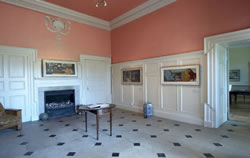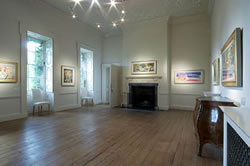 |
Installation view

Installation view
“I paint life as I see it, hear it, feel it, smell it, and think it - but above all see it... It is sifted through one's intelligence... The canvas receives life, becomes alive, gives back life, and finally shows the relativity of nature."
Ivon Hitchens
We would like here to thank Unit One for their support. Andrew and his company, in a remarkably generous act, retrospectively waived the entire shipping and installation fees for the exhibition here this summer. Their considerable contribution is most gratefully acknowledged. |
|
|
Ivon Hitchens | Paintings
27 May - 27 August 2007
Since it opened to the public four years ago, Narborough Hall has hosted exhibitions by internationally recognised artists including Barry Flanagan and Bridget Riley during the summer months.
During the summer of 2007 visitors to Narborough Hall were able to enjoy an exhibition of works by Ivon Hitchens, one of the most significant British painters of the twentieth century.The retrospective exhibition brought together a selection of paintings from the 1920s through to the 1970s, including his famous landscapes as well as still-lifes and interiors.
After briefly studying at the St. John's Wood Art School, Ivon Hitchens attended the Royal Academy Schools in London intermittently between 1911 and 1919. In the 1920s and 30s he was part of an avant-garde circle of artists, known as the London Group, which included Barbara Hepworth, Henry Moore, Naum Gabo, Paul Nash and Ben Nicholson. In 1940 he left London and moved to a patch of woodland near Petworth, West Sussex, where he lived and worked for the next 40 years.
Ivon Hitchens painted mostly outdoors and his technique developed from a tonal treatment that recalls the informality of Constable's sketches where the motif is clearly visible, to his later more abstracted and colourful works where the brushmark becomes much wider and bolder.
His landscape paintings are better understood as being not pictures of woodland scenery but experiences, memories of having been in a specific landscape. He registered the sensations of the weather and woods around him, with oil paint often damp and earthy in colour and laid on to the canvas with forthright sweeps and stabs of broad brushes.
|